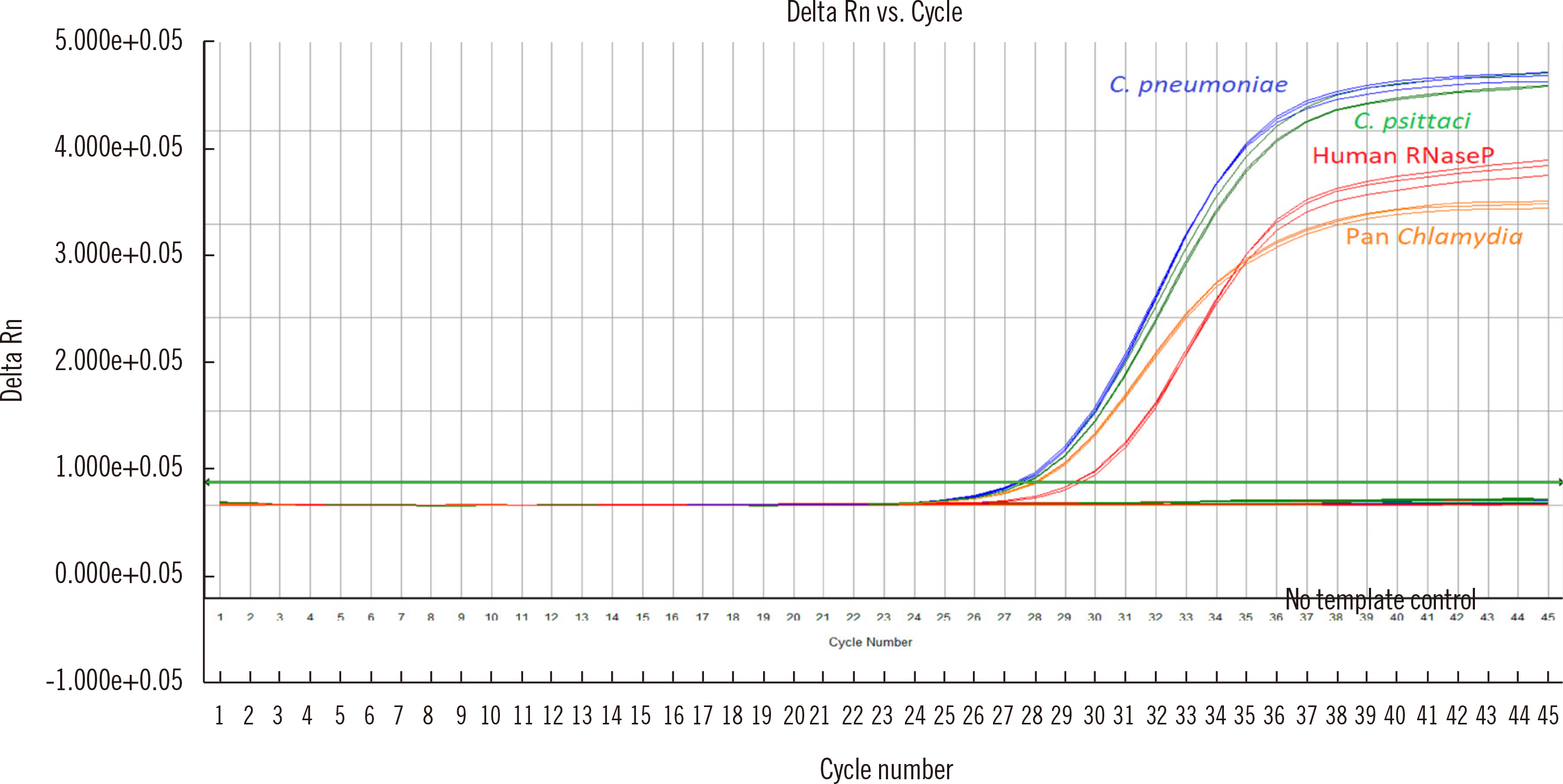Ann Lab Med.
2023 Jul;43(4):375-380. 10.3343/alm.2023.43.4.375.
Multiplex Real-time PCR Assay for the Detection of all Chlamydia Species and Simultaneous Differentiation of C. psittaci and C. pneumoniae in Human Clinical Specimens
- Affiliations
-
- 1Division of Bacterial Diseases, Centers for Disease Control and Prevention, Atlanta, GA, USA
- 2Applied Bioinformatics Laboratory, Atlanta, GA, USA
- 3School of Biological Sciences, Georgia Institute of Technology, Atlanta, GA, USA
- KMID: 2551955
- DOI: http://doi.org/10.3343/alm.2023.43.4.375
Abstract
- We developed and assessed the performance of a new multiplex real-time PCR assay for the detection of all Chlamydia species and simultaneous differentiation of Chlamydia psittaci and Chlamydia pneumoniae—two important human respiratory pathogens—in human clinical specimens. Next-generation sequencing was used to identify unique targets to design real-time PCR assays targeting all Chlamydia species, C. psittaci, and C. pneumoniae. To validate the assay, we used a panel of 49 culture isolates comprising seven C. psittaci genotypes, eight C. pneumoniae isolates, seven other Chlamydia species, and 22 near-neighbor bacterial and viral isolates, along with 22 specimens from external quality assessment (EQA) panels and 34 nasopharyngeal and oropharyngeal swabs and cerebrospinal fluid, stool, and sputum specimens previously identified as positive or negative for C. psittaci or C. pneumoniae. The assays were 100% specific, with limits of detection of 7.64– 9.02 fg/μL. The assay results matched with historical assay results for all specimens, except for one owing to the increased sensitivity of the new C. psittaci assay; the results of the EQA specimens were 100% accurate. This assay may improve the timely and accurate clinical diagnosis of Chlamydia infections and provide a greater understanding of the burden of disease caused by these agents.
Figure
Reference
-
1. Guo W, Li J, Kaltenboeck B, Gong J, Fan W, Wang C. 2016; Chlamydia gallinacea, not C. psittaci, is the endemic chlamydial species in chicken (Gallus gallus). Sci Rep. 6:19638. DOI: 10.1038/srep19638. PMID: 26778053. PMCID: PMC4726042.2. AbdelRahman YM, Belland RJ. 2005; The Chlamydial developmental cycle. FEMS Microbiol Rev. 29:949–59. DOI: 10.1016/j.femsre.2005.03.002. PMID: 16043254.3. Read TD, Joseph SJ, Didelot X, Liang B, Patel L, Dean D. 2013; Comparative analysis of Chlamydia psittaci genomes reveals the recent emergence of a pathogenic lineage with a broad host range. mBio. 4:e00604–12. DOI: 10.1128/mBio.00604-12. PMID: 23532978. PMCID: PMC3622922.4. Kaleta EF, Taday EM. 2003; Avian host range of Chlamydophila spp. based on isolation, antigen detection and serology. Avian Pathol. 32:435–61. DOI: 10.1080/03079450310001593613. PMID: 14522700.5. Longbottom D, Livingstone M. 2006; Vaccination against chlamydial infections of man and animals. Vet J. 171:263–75. DOI: 10.1016/j.tvjl.2004.09.006. PMID: 16490708.6. Balsamo G, Maxted AM, Midla JW, Murphy JM, Wohrle R, Edling TM, et al. 2017; Compendium of measures to control Chlamydia psittaci infection among humans (psittacosis) and pet birds (avian chlamydiosis), 2017. J Avian Med Surg. 31:262–82. DOI: 10.1647/217-265. PMID: 28891690.7. Conklin L, Adjemian J, Loo J, Mandal S, Davis C, Parks S, et al. 2013; Investigation of a Chlamydia pneumoniae outbreak in a federal correctional facility in Texas. Clin Infect Dis. 57:639–47. DOI: 10.1093/cid/cit357. PMID: 23723194. PMCID: PMC4678872.8. Joseph SJ, Marti H, Didelot X, Castillo-Ramirez S, Read TD, Dean D. 2015; Chlamydiaceae genomics reveals interspecies admixture and the recent evolution of Chlamydia abortus infecting lower mammalian species and humans. Genome Biol Evol. 7:3070–84. DOI: 10.1093/gbe/evv201. PMID: 26507799. PMCID: PMC4994753.
Article9. Wolff BJ, Morrison SS, Pesti D, Ganakammal SR, Srinivasamoorthy G, Changayil S, et al. 2015; Chlamydia psittaci comparative genomics reveals intraspecies variations in the putative outer membrane and type III secretion system genes. Microbiology (Reading). 161:1378–91. DOI: 10.1099/mic.0.000097. PMID: 25887617. PMCID: PMC4635502.10. Mitchell SL, Wolff BJ, Thacker WL, Ciembor PG, Gregory CR, Everett KD, et al. 2009; Genotyping of Chlamydophila psittaci by real-time PCR and high-resolution melt analysis. J Clin Microbiol. 47:175–81. DOI: 10.1128/JCM.01851-08. PMID: 19005152. PMCID: PMC2620869.
Article11. Wolff BJ, Morrison SS, Winchell JM. 2018; Development of a multiplex TaqMan real-time PCR assay for the detection of Chlamydia psittaci and Chlamydia pneumoniae in human clinical specimens. Diagn Microbiol Infect Dis. 90:167–70. DOI: 10.1016/j.diagmicrobio.2017.11.014. PMID: 29291900.12. Voigt A, Schöfl G, Saluz HP. 2012; The Chlamydia psittaci Genome: A comparative analysis of intracellular pathogens. PLoS One. 7:e35097. DOI: 10.1371/journal.pone.0035097. PMID: 22506068. PMCID: PMC3323650.13. Emery SL, Erdman DD, Bowen MD, Newton BR, Winchell JM, Meyer RF, et al. 2004; Real-time reverse transcription-polymerase chain reaction assay for SARS-associated coronavirus. Emerg Infect Dis. 10:311–6. DOI: 10.3201/eid1002.030759. PMID: 15030703. PMCID: PMC3322901.
Article14. Thurman KA, Warner AK, Cowart KC, Benitez AJ, Winchell JM. 2011; Detection of Mycoplasma pneumoniae, Chlamydia pneumoniae, and Legionella spp. in clinical specimens using a single-tube multiplex real-time PCR assay. Diagn Microbiol Infect Dis. 70:1–9. DOI: 10.1016/j.diagmicrobio.2010.11.014. PMID: 21397428. PMCID: PMC7126442.
Article15. Mukhopadhyay S, Clark AP, Sullivan ED, Miller RD, Summersgill JT. 2004; Detailed protocol for purification of Chlamydia pneumoniae elementary bodies. J Clin Microbiol. 42:3288–90. DOI: 10.1128/JCM.42.7.3288-3290.2004. PMID: 15243095. PMCID: PMC446299.
Article16. Smieja M, Mahony JB, Goldsmith CH, Chong S, Petrich A, Chernesky M. 2001; Replicate PCR testing and probit analysis for detection and quantitation of Chlamydia pneumoniae in clinical specimens. J Clin Microbiol. 39:1796–801. DOI: 10.1128/JCM.39.5.1796-1801.2001. PMID: 11325993. PMCID: PMC88028.
Article
- Full Text Links
- Actions
-
Cited
- CITED
-
- Close
- Share
- Similar articles
-
- Detection of Chlamydia pneumoniae by 'Touchdown' PCR
- Comparative Evaluation of Multiplex Real-Time PCR Assays for Six Pathogens of Sexually Transmitted Infections
- Evaluation of a Multiplex Real-time PCR Assay for the Detection of Respiratory Viruses in Clinical Specimens
- Multiplex Real-time Polymerase Chain Reaction Assays for Simultaneous Detection of
Vibrio cholerae ,Vibrio parahaemolyticus , andVibrio vulnificus - Evaluation of EuDxâ„¢-PN MLC Detection Kit for Detection of Mycoplasma pneumoniae, Chlamydophila pneumoniae, and Legionella pneumophila in Respiratory Specimens


